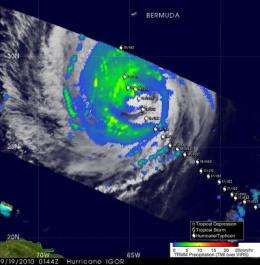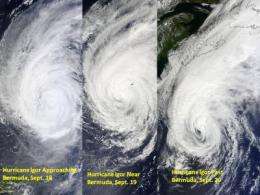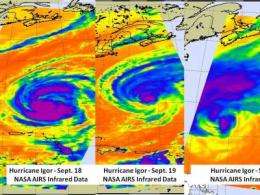NASA's MODIS and AIRS instruments watch Igor changing shape, warming over 3 days

The Moderate Resolution Imaging Spectroradiometer or MODIS, is an instrument that flies on NASA's Aqua and Terra satellites and provides incredible views of tropical cyclones like Hurricane Igor, from its vantage point in space. Imagery from the MODIS instruments on these two satellites captured from Sept. 18 to 20 showed that powerful Hurricane Igor in the Atlantic Ocean is morphing from a rounded storm to more of a comma-shaped storm.
The MODIS instrument on NASA's Terra satellite captured a visible image of Igor at 11:30 am on Sept. 18, while MODIS in the Aqua satellite captured Igor's center just southwest of Bermuda on Sept. 19 at 1:30 p.m. EDT. In imagery on both days, Hurricane Igor maintained a rounded shape and its eye was cloud-filled. When the MODIS instrument that flies aboard NASA's Terra satellite captured Igor after it passed Bermuda on Sept. 20 at 11:15 a.m. EDT, the imagery showed the Igor appeared elongated from south to north, and more resembled a comma-shape. There was even an eye visible in the latest image.
The Atmospheric Infrared Sounder Instrument (AIRS) that flies on NASA's Aqua satellite captured infrared images of Hurricane Igor's cold cloud temperatures and cloud cover on Sept. 18, Sept. 19, and Sept. 20. Igor lost its circular shape by Sept. 20, and there were very few high, strong thunderstorms where the cloud tops were colder than -63F. Infrared data from AIRS on Sept. 20 indicated that Igor was losing its strength as the cloud tops in the thunderstorms within were warming (less high in the atmosphere) and waning.

NASA and JAXA's Tropical Rainfall Measuring Mission (TRMM) satellite also continues to fly over Igor as he makes his track northward in the Atlantic Ocean.
Hurrricane Igor continued to weaken as the Tropical Rainfall Measuring Mission (TRMM) satellite passed over on September 19, 2010 at 0144 UTC showing that the hurricane no longer had an eye. Igor's wind speeds had decreased to about 75 knots (~86 mph) when TRMM collected the TRMM Microwave Imager (TMI) data used in the precipitation analysis. TRMM is managed by both NASA and the Japanese Space Agency.
By 2p.m. EDT on Sept. 20, all warnings and watches for Bermuda had been discontinued. Igor had moved about 350 miles north-northeast of Bermuda and was headed into the North Atlantic. It was located near 37.1 North and 62.5 West. Now, a tropical storm watch is in effect for the coast of Newfoundland from Stones Cove northward and Westward to Jones Harbour, Canada.

Igor was just barely a hurricane, with maximum sustained winds near 75 mph. It was moving northeast at 26 mph. Its minimum central pressure was 965 millibars.
Large swells will continue to affect Bermuda and the U.S. East coast through Tuesday, Sept. 21, causing life-threatening rip-currents and rough surf. Swells affecting the Lesser Antilles, the Virgin Islands, Puerto Rico, Hispaniola and the Bahamas will subside over the next couple of days.
Provided by NASA's Goddard Space Flight Center





















